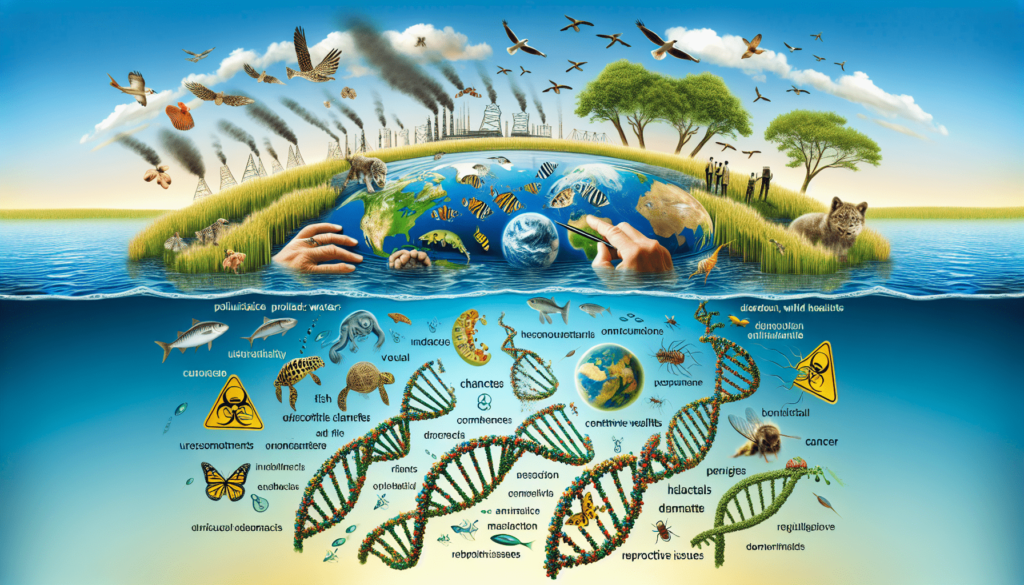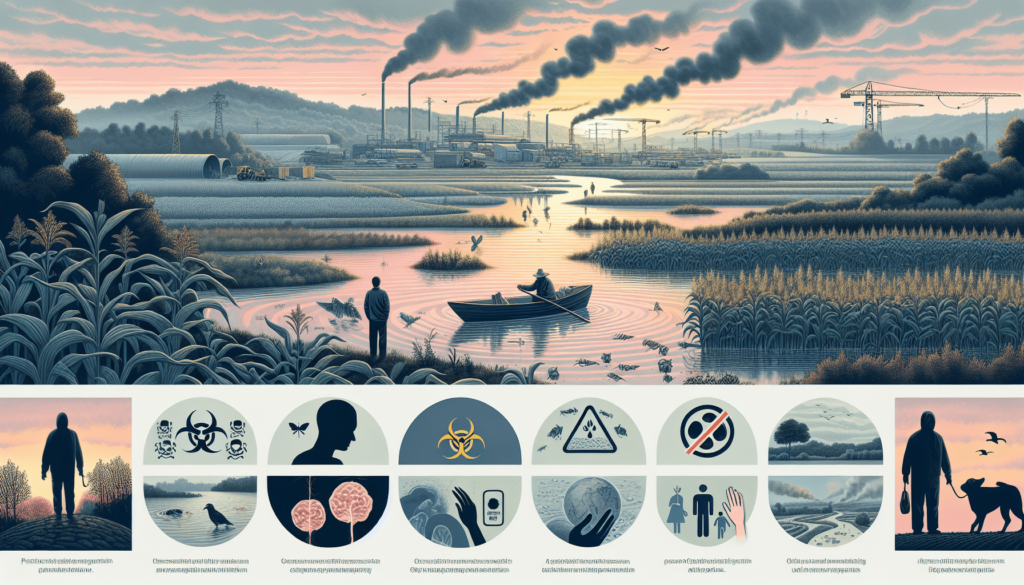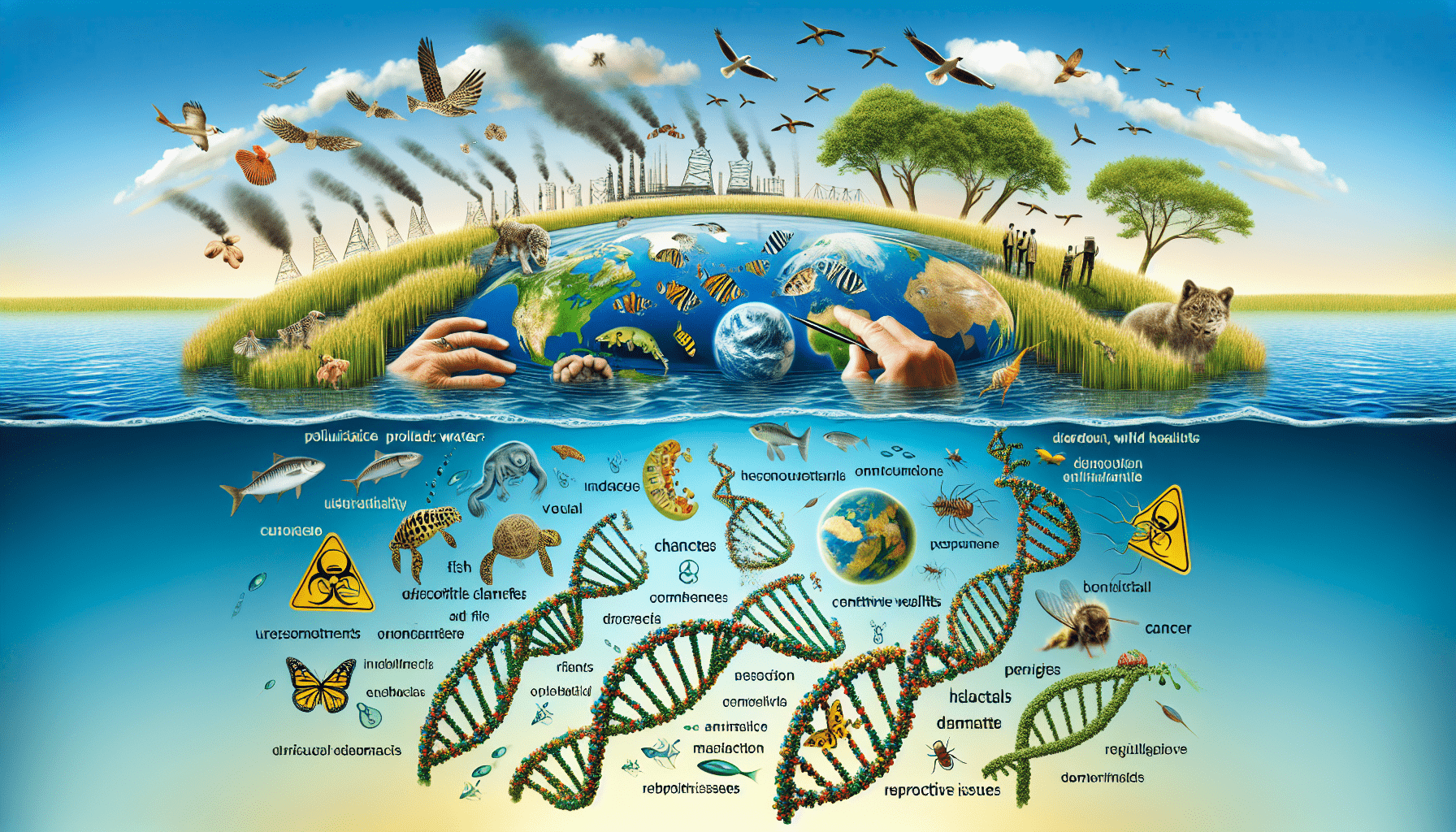In this article, you will explore the profound effects that pesticides have on both the environment and our health. As you delve into the topic, you will uncover how these agricultural chemicals not only protect crops from pests but also pose significant risks to ecosystems and human well-being. By understanding the intricate relationship between pesticides and their impact, we can strive towards implementing sustainable solutions that balance the need for agricultural productivity and environmental preservation. Grab your magnifying glass, and let’s uncover the hidden dangers of pesticides together.

Pesticides and Their Uses
Pesticides are chemical substances used to control, mitigate, or eliminate pests that can damage crops, spread diseases, or harm humans and animals. They play a crucial role in modern agriculture and public health by ensuring the adequate production of food and safeguarding against harmful pests. Pesticides can be classified into different categories based on their chemical composition and the pests they target. These classifications include insecticides, herbicides, fungicides, rodenticides, and bactericides, among others.
Classification of Pesticides
Insecticides are designed to target and control insects that pose a threat to crops or human health. They can be further categorized into broad-spectrum insecticides, which are effective against a wide range of insect species, and narrow-spectrum insecticides, which target specific types of insects. Herbicides, on the other hand, are used to eliminate or suppress unwanted weeds that compete with crops for resources. Fungicides are employed to prevent or manage fungal infections in plants, ensuring their healthy growth. Rodenticides are designed to control rodents such as rats and mice, while bactericides combat bacterial diseases that affect plants.
Common Uses of Pesticides
Pesticides are extensively utilized in agriculture to protect crops from pests that can cause significant yield losses. They are employed to control insect infestations, prevent weed growth, manage fungal infections, and combat diseases caused by bacteria. Additionally, pesticides find application in public health programs to control disease-carrying vectors such as mosquitoes, ticks, and flies. They are also used in non-agricultural settings such as homes, schools, and public spaces to maintain cleanliness and eliminate pests that can harm humans or damage property.
Modes of Application
Pesticides can be applied using various methods depending on the target pest, the type of pesticide used, and the scale of application. Common modes of application include spraying, dusting, granulation, and seed treatment. Spraying is the most widely used method and involves the use of liquid formulations, which are sprayed onto crops using hand-held or mechanized sprayers. Dusting involves the application of powdered formulations, while granulation involves the use of granular formulations. Seed treatment involves coating seeds with pesticides to protect them from pest infestations before germination.
Environmental Impact of Pesticides
While pesticides are essential for managing pests and ensuring productivity, they also have significant environmental impacts that need to be carefully considered. One of the key concerns is the contamination of soil, which can occur due to the repeated application of pesticides. Pesticides can accumulate in the soil and persist for extended periods, impacting soil health and potentially leading to the contamination of groundwater. Contaminated soil can also harm beneficial soil organisms, disrupting the natural balance of the ecosystem.
Contamination of Water Bodies
Pesticides can enter water bodies through various pathways, including runoff from treated fields and direct application to surface water for controlling aquatic pests. This contamination can have detrimental effects on aquatic organisms such as fish, amphibians, and invertebrates. Some pesticides can persist in water bodies for long periods and accumulate in the tissues of aquatic organisms, leading to bioaccumulation and potential ecological imbalances.
Effects on Non-target Organisms
Pesticides intended for specific pests often affect non-target organisms, including beneficial insects, birds, and mammals. For example, insecticides meant to control harmful insects can harm bees, butterflies, and other pollinators essential for plant reproduction. Additionally, birds and mammals that consume plants or prey on insects may inadvertently ingest pesticides, leading to a cascade of negative effects on the overall ecosystem.
Persistence and Bioaccumulation of Pesticides
The persistence of pesticides refers to their ability to remain active in the environment over a prolonged period. Some pesticides, such as organochlorines, can persist for several years, while others degrade more quickly. The degradation rates of pesticides depend on factors such as temperature, sunlight exposure, soil type, and microbial activity. Bioaccumulation, on the other hand, refers to the accumulation of pesticide residues in the tissues of organisms over time. This can occur when organisms consume contaminated food or water and are unable to eliminate the pesticides efficiently.
Degradation Rates and Persistence in the Environment
Pesticides can degrade through various processes, including photodegradation (breakdown by sunlight), hydrolysis (breakdown in water), and microbial degradation (breakdown by microorganisms). However, some pesticides have long environmental half-lives, meaning they persist in the environment for extended periods, increasing the risk of environmental contamination. Pesticide persistence can vary widely depending on their chemical properties, formulation, and application methods.
Bioaccumulation in Food Chains and Ecosystems
When organisms consume food or water contaminated with pesticides, the residues can accumulate in their bodies over time. This accumulation occurs due to the inability of organisms to metabolize or eliminate the pesticides efficiently. As a result, predators higher up the food chain, such as birds or mammals, can accumulate high levels of pesticides by consuming contaminated prey. This bioaccumulation can lead to adverse health effects in these organisms and disrupt the balance of ecosystems.

Health Hazards of Pesticides
Pesticides pose potential health risks to humans, both through acute toxicity and chronic exposure. Acute toxicity refers to the immediate and severe health effects that can occur shortly after a single exposure to high levels of pesticides. These effects can range from mild symptoms such as nausea and dizziness to more severe outcomes such as respiratory problems, skin irritation, or even death in extreme cases. Chronic exposure to pesticides, on the other hand, refers to long-term exposure to low levels of pesticides. This type of exposure has been linked to various health risks, including developmental disorders, reproductive issues, hormonal imbalances, and an increased risk of certain cancers.
Occupational Hazards for Farmers and Pesticide Applicators
Farmers and pesticide applicators are particularly vulnerable to the health hazards associated with pesticide use. They often come into direct contact with pesticides during handling, mixing, and application, increasing their exposure levels. Without proper protective measures and adherence to safety protocols, these individuals can experience acute poisoning or long-term health effects from chronic exposure. It is crucial for farmers and pesticide applicators to receive appropriate training, use personal protective equipment, and follow recommended safety guidelines to minimize the risks associated with pesticide use.
Residues in Food
Although stringent regulations and safety standards exist to regulate pesticide residues in food, concerns about consumer exposure and potential health effects persist. Pesticide residues can remain on fruits, vegetables, and other food products even after they have been treated. While most residues are present at very low levels and are considered safe for consumption, there is ongoing debate regarding the cumulative effects of long-term exposure to multiple pesticide residues. Some studies suggest that chronic exposure to pesticide residues in food may increase the risk of certain health issues, including developmental disorders, hormonal imbalances, and certain types of cancer.
Regulations and Safety Standards for Pesticide Residues
To protect consumer health, regulatory agencies around the world have established maximum residue limits (MRLs) for pesticides in food. These MRLs are set based on scientific assessments of the acceptable daily intake of each pesticide and aim to ensure that the levels detected in food do not pose significant health risks. Monitoring programs are in place to check compliance with these standards, and food producers are required to follow good agricultural practices to minimize pesticide residues. Nevertheless, ongoing research and continuous monitoring are vital to address emerging concerns and maintain consumer safety.
Health Concerns and Consumer Exposure
Consumer exposure to pesticide residues in food depends on various factors, including dietary habits, food choices, and cooking methods. Certain groups, such as infants, children, and pregnant women, may be more susceptible to the potential health effects of pesticide residues due to their unique vulnerabilities. While the majority of consumed food products contain pesticide residues within acceptable limits, it is important to promote awareness of food safety practices and encourage the consumption of a balanced diet that incorporates a variety of fruits, vegetables, and other food sources to minimize potential exposure.
Impact on Biodiversity
The use of pesticides has raised concerns about its impact on biodiversity, particularly the loss of beneficial insects and pollinators. Pollinators such as bees, butterflies, and other insects play a crucial role in the fertilization of plants, enabling the production of fruits, vegetables, and seeds. However, some pesticides, particularly insecticides, can have unintended negative effects on these pollinators. Exposure to insecticides can lead to reduced foraging ability, impaired navigation and communication, and decreased reproductive success in bees and other pollinators. The decline in pollinator populations can have far-reaching consequences for ecosystems, reducing biodiversity and impacting food production.
Disruption of Ecosystems and Food Webs
Pesticides not only affect target pests but also disrupt ecosystems and food webs. The elimination of pests through pesticide use can disturb the natural balance of predator-prey relationships and lead to secondary pest outbreaks. For example, the indiscriminate use of broad-spectrum insecticides can kill both harmful insects and beneficial natural enemies, such as ladybugs or spiders, which help control pest populations naturally. This disruption can create a cascade effect, impacting the abundance and diversity of species within the ecosystem and potentially causing ecological imbalances.
Pesticide Drift and Air Pollution
Pesticide drift refers to the unintentional movement of pesticides through the air to areas beyond the intended target. Drift can occur during pesticide application due to factors such as wind speed, spray droplet size, and spray equipment calibration. When pesticides drift, they can contaminate nearby areas, including neighboring crops, residential areas, and water bodies. Additionally, volatile pesticides can undergo volatilization, where they evaporate into the atmosphere and contribute to air pollution. These airborne pesticides can have direct health effects on humans and animals when inhaled and can also impact ecosystems when deposited onto soil or water surfaces.
Volatilization and Atmospheric Transportation of Pesticides
Some pesticides have high volatility, meaning they can vaporize and be transported through the air over long distances. Volatile pesticides can be released into the atmosphere during or after application and can travel to areas far from the original application site. Atmospheric transportation of pesticides can result in their deposition onto soil, water bodies, or vegetation in distant locations, potentially causing unintended environmental contamination and health risks.
Health Effects of Pesticide Drift
Pesticide drift can pose health risks to individuals living or working in close proximity to treated areas. Inhaling airborne pesticides can lead to respiratory problems, allergic reactions, eye irritation, and skin disorders. Children, the elderly, and individuals with pre-existing respiratory conditions are particularly susceptible to the health effects of pesticide drift. Proper adherence to application techniques, wind calibration, and buffer zones can help minimize pesticide drift and reduce the associated health risks.
Effects on Water Quality and Aquatic Life
Pesticides can impact water quality through runoff from treated fields and their direct application to surface water bodies. When pesticides are applied, they can be transported off-site through rainwater or irrigation runoff, leading to the contamination of nearby surface water. This contamination can have detrimental effects on aquatic life, particularly fish and other aquatic organisms. Pesticides can cause toxic effects, such as reduced growth, impaired reproduction, and increased mortality in these organisms. Additionally, certain pesticides can persist in water bodies, posing long-term risks to aquatic ecosystems.
Runoff and Contamination of Surface Water
The runoff of pesticides from agricultural fields can carry significant amounts of these chemicals into nearby rivers, streams, and lakes. This runoff can occur during heavy rainfall or excessive irrigation, particularly when pesticides are not applied according to recommended practices. The contamination of surface water with pesticides can have immediate and long-term effects on the health of aquatic organisms and the overall quality of water resources. Ensuring proper application timing, dose, and methods can help minimize runoff and reduce pesticide contamination of surface water.
Toxicity to Fish and Other Aquatic Organisms
Pesticides that reach water bodies can have toxic effects on fish, amphibians, invertebrates, and other aquatic organisms. The direct exposure to pesticides can lead to reduced growth, impaired reproduction, behavioral abnormalities, and even mortality. Certain pesticides, particularly those with high toxicity or persistence in water, can cause long-term damage to aquatic ecosystems by disrupting the balance of species interactions and impairing the health of sensitive organisms. Implementation of buffer zones, vegetative buffers, and precision application techniques can help mitigate the impacts of pesticides on water quality and aquatic life.
Pesticides and Climate Change
The use of pesticides can contribute to climate change through the emission of greenhouse gases (GHGs) during their manufacturing, transportation, and application processes. GHGs, such as carbon dioxide (CO2) and nitrous oxide (N2O), are known to contribute to global warming and climate change. The manufacture and transportation of pesticides require energy, which often comes from fossil fuel sources, releasing CO2 into the atmosphere. Additionally, certain agricultural practices associated with pesticide use, such as tillage and nitrogen fertilizer use, can result in increased N2O emissions, further exacerbating the greenhouse effect.
Contribution to Greenhouse Gas Emissions
The production, distribution, and application of pesticides contribute to GHG emissions in several ways. The manufacturing process involves energy-intensive activities and the use of fossil fuel-derived inputs, resulting in CO2 emissions. The transportation of pesticides to various locations also requires the use of vehicles that emit CO2. Moreover, certain agricultural practices associated with pesticide use, such as the use of machinery and irrigation, can indirectly contribute to GHG emissions. Overall, reducing GHG emissions from the pesticide life cycle is essential for mitigating the impact of agriculture on climate change.
Effects of Climate Change on Pesticide Use and Effectiveness
Climate change can influence both the distribution and abundance of pests, complicating pest management practices that rely on pesticides. Changes in temperature, precipitation patterns, and the frequency of extreme weather events can affect pest populations, crop growth, and the efficacy of pesticides. Rising temperatures can favor the spread of certain pests, while increased rainfall can promote the development of fungal diseases that require fungicides for control. Furthermore, climate change can alter the timing and intensity of pest outbreaks, requiring adjustments in pesticide application strategies and the development of more sustainable pest management approaches.
Alternatives to Pesticides
While pesticides have proven effective in managing pests, there is growing interest in adopting alternative approaches that minimize their use and potential side effects. Integrated Pest Management (IPM) practices aim to combine various pest control strategies in a holistic and environmentally sustainable manner. IPM emphasizes the use of biological control methods, cultural practices, mechanical controls, and the judicious use of pesticides when necessary. Biological control involves the introduction or enhancement of natural enemies of pests to suppress their populations. Organic farming techniques, which avoid the use of synthetic pesticides and focus on soil health and biodiversity, are gaining popularity as a sustainable alternative.
Integrated Pest Management (IPM) Practices
IPM is a comprehensive approach to pest management that integrates various strategies to minimize pest damage and reduce reliance on pesticides. This approach involves monitoring and identifying pests, assessing potential risks, and implementing a combination of cultural, biological, and chemical controls. Culturally, IPM promotes practices such as crop rotation, planting resistant varieties, and maintaining optimal growing conditions to minimize pest pressure. Biological controls within IPM involve the use of beneficial insects, natural enemies, and microbial agents to suppress pest populations. Chemical controls, when necessary, prioritize the use of selective and low toxicity pesticides while minimizing environmental impacts.
Biological Control Methods
Biological control is an environmentally friendly approach to pest management that relies on natural enemies to control pest populations. This approach can involve the introduction of beneficial predators, parasitoids, or pathogens that target specific pests. For example, ladybugs can be introduced into an agricultural field to control aphids, reducing the need for insecticides. This method harnesses the natural balance of the ecosystem to maintain pest populations at manageable levels and minimize the reliance on chemical pesticides. Biological control methods can be effective in reducing pest outbreaks and preserving biodiversity while minimizing potential risks to human health and the environment.
Organic Farming Techniques
Organic farming is an agricultural system that avoids the use of synthetic pesticides, genetically modified organisms (GMOs), and synthetic fertilizers. Instead, organic farmers rely on natural processes, such as crop rotation, composting, and biological pest control, to maintain soil health, suppress pests, and promote crop productivity. Organic farming techniques prioritize the use of organic inputs and sustainable practices to minimize environmental impacts and preserve natural resources. The organic farming movement has gained popularity due to increasing consumer demand for pesticide-free and environmentally friendly food products.
In conclusion, while pesticides play a crucial role in modern agriculture and public health, their use has significant environmental and health impacts. The contamination of soil and water bodies, the effects on non-target organisms, persistence and bioaccumulation, health hazards, residues in food, impact on biodiversity, pesticide drift and air pollution, effects on water quality and aquatic life, and their contribution to climate change are all important considerations when evaluating the use of pesticides. Efforts should be made to adopt alternative approaches such as integrated pest management practices, biological control methods, and organic farming techniques that minimize the use of pesticides and promote sustainable agriculture while ensuring food security and public health.

